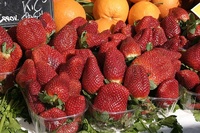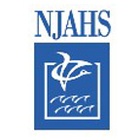I don’t quite know what to make of the notion of Japanese American food. What I can talk about is what I ate as a child and as an adult, and how my diet and tastes have changed and how I still eat plenty of foods that I ate as a child. I grew up on farms in Southern California during the pre World War II days. My mother was a Kibei-Nisei, which is to say that she was born here in Oxnard and then sent to Japan for her early education. This was due to the fact that her mother died in childbirth and so she and her other 2 sisters were sent to relatives in Japan because my grandfather could not run his farm and raise such young children.
When she came to the U.S. to be married to my father, she was 16 and it must have been hard on her to come to a strange land and to become a farmer’s wife. And added to that, these were depression times and everybody was having a hard time. Nevertheless, there was always food on the table, most of it very Japanese. White rice was the everyday staple, and what we ate with it was Japanese. There was a vibrant Japanese community in Southern California, so even farm folks had access to fresh fish of all kinds. I remember tuna, mackerel, sand dabs, yellowtail, and lots of other kinds in season, like barracuda, sardines, and squid, octopus, clams, and shrimp. Along with the fresh stuff we had fish imported from Japan: canned goods, dried fish like iriko, unagi, shio buri. All of the seafood was prepared in the usual Japanese ways like frying, grilling, (I do remember half dried salted Spanish mackerel), boiling in soy sauce and sugar, or raw. And there was shrimp tempura and a great array of vegetables.
One image I retain is of my mother butchering large, whole tuna. On the local strawberry farms, it was customary to have gangs of itinerant bachelor Japanese men who came to help harvest strawberries. They slept in rough bunkhouses, and my father and mother felt that you had to feed these men well because of the hard work that they did. So, filleting a whole tuna was a common occurrence so that they could have their fill of sashimi and rice. Barnyard chickens provided eggs and were slaughtered for company or special occasions.
During the harvest season and at other times a vendor with a truck came from Los Angeles to sell Japanese foodstuffs, and so that was how whole tuna and the other seafood arrived. He would also have tofu, agedofu, maybe some Japanese vegetables and other imported stuff so that we were well provisioned. I think that the fish vendor also served as an informal purveyor of gossip and information about what everybody else was doing. I remember a ken picnic where I won a case of shoyu in a raffle, a big thrill for a small child.
Still, my father shopped in the local grocery stores and so as I remember, breakfast was a very American affair. There always was coffee, with Carnation canned milk and sugar, bread for toasting with butter and jam, and bacon and eggs. We never had miso soup for breakfast, and after we got a refrigerator, there was milk and so I also ate cornflakes and rice crispies.
Going to school meant taking a lunch, so I had sandwiches made with mayonnaise and my favorite, boiled ham. Living in Southern California meant lots of fruit, and I remember immense navel oranges which had large navels with baby orange segments, tangerines, all kinds of grapes and the usual array of apples, pears, apricots, peaches, etc.
We had a vegetable garden and my mother made fresh tsukemono out of baby daikon and radishes and other vegetables like cucumbers and cabbage. It was served with rice at any meal, and we poured green tea over cold rice to eat with tsukemono, umeboshi and takuan. A dish called okazu which was a stir fry with sliced beef, or pork, or chicken, cooked with vegetables, shoyu and sugar. One especially memorable dish was sato-joy weenies, hot dogs that were sliced up and cooked in the ubiquitous soy sauce and sugar.
My mother never had an oven, so she was unable to bake or roast, but some American style dishes became part of our dinners: steak, hamburgers, pork chops, and fried chicken. Treats like stew and potato salad became additions to the table and gradually meals became a mixture of Japanese and American. I also remember the Helms bakery man coming to the farms with his panel truck and so bread and other baked items were available. When my mom wanted to give us a special treat, she bought cream puffs. I will never forget the taste of all that whipped cream inside the puffed up outer shell. How on earth were these heavenly things made?
We sometimes went gathering abalone at Dana Point and also hunting octopus under the rocks. The abalone was made into sashimi and what a sublime flavor. The octopus was rubbed with salt and boiled, also a special treat.
But living in Southern California meant other food influences were close by. We went to China meshi (going to a Chinese restaurant) in Los Angeles where wonderful dishes like pakkai, almond duck, chasiu, chow mein were treats. Some of these made it into our home cuisine, along with the local Mexican fare like flour tortillas, tamales, chili and beans.
Looking back on that childhood makes me nostalgic for Southern California as it once was, more rural and clear. I still crave and make a great many of those dishes that I ate as a child, but after all the years of my interest in cooking, I can do Italian, French, Chinese. We Americans are really lucky. If you want, you can get almost any foodstuff, go to a huge array of restaurants and you can watch the food channel to learn all sorts of techniques and recipes. But when I feel like comfort food, I make butadofu, or tempura, sashimi and fried squid, and always, hot white rice. With shoyu. And maybe a green salad with fennel, avocadoes, heirloom tomatoes. It’s a mix from the world, a vast and endlessly varied array of things to eat. My world overflows with the bounty of it and I feel blessed.
*This article was originally published in Nikkei Heritage Vol. XX, No. 1 (Winter - Spring 2009), a journal of the National Japanese American Historical Society.
© 2009 National Japanese American Historical Society




